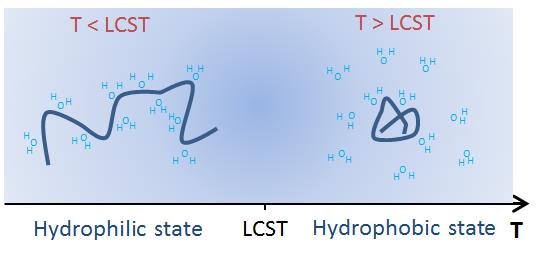The ultimate goal of a wound dressing in the treatment of injuries is to get the fastest and best healing which can be achieved with a porous structure that mimics biological tissue and contains drugs to release. Electrospinning, a technique that uses an electrical field to produce micro to nano-size fibers of polymers, is one of the most suitable methods to obtain porous membranes. Moreover, the possibility of using co-axial electrospinning which consists of two coaxial needles one inside the other allows the electrospinning of two solutions simultaneously to obtain core-shell fibers with a polymer core containing a drug to be delivered to the wound for example[1].
Poly (N-vinylcaprolactam) (PNVCL), a thermoresponsive polymer showing hydrophobic-hydrophilic balanced chain in its structure, presents the characteristic of changing conformation according to the temperature. Below a specific temperature known as "Lower Critical Solution Temperature" (LCST)[2], the polymer is in an extended conformation; above it the polymer collapses as shown schematically in Figure 1.

Figure 1: Changes of PNVCL conformation in response to temperature variation.
Similar change of conformation which occurs at temperatures between 30 and 45oC for PNVCL has benefited drug delivery for other polymers such as Poly(N-ethylacrylamide), poly(N-acrylopiperidine), poly(N-isopropylacrylamide)[3]. However, differently from some of these other polymers, PNVCL is nontoxic, non-ionic and water soluble, making PNVCL an interesting candidate for drug delivery applications[2].
The purpose of this work was therefore to evaluate the possibility of electrospinning PNVCL and obtaining hollow fibers of PNVCL containing Caffeine, a drug which is used to relieve pain. The electrospinning of the material was optimized as well as material properties such as molar mass and as far as process parameters are concerned. Several experiments were carried out using a wide range of solution and process parameters to fix their optimal values. Once these optimal values were fixed, core-shell fibers were obtained. Two solutions were then used and electrospun simultaneously through two coaxial needles: the drug solution (Caffeine) forming the inner jet and the polymer solution forming the outer jet.
The resulting membranes from PNVCL electrospinning with this optimal solution and process parameters presented good, continuous and smooth nanofibers. The morphology of PNVCL nanofibers was evaluated by Scanning Electron Microscope (SEM) at 5k as shown in the figure 2. Also, it was possible to obtain hollow fibers and it was evaluated by Transmission electron microscopy (TEM).

Figure 2: SEM image of PNVCL nanofibers 35% (w/v) in water
The results obtained showed that it is possible to use electrospun PNVCL to encapsulate an active ingredient for wound dressing application. In particular, it was possible to control the process parameters to obtain fibers of tailored diameter. The morphology and the diameter of thermoresponsive PNVCL nanofibers were shown to be dependent on solution parameters such as concentration, viscosity and molar mass and process parameters such as voltage and flow rate. Obtained results after optimizing these mentioned parameters are essential for PNVCL coaxial electrospinning and drug release application.
École de technologie supérieure (ETS) de Montréal; University of São Paulo – USP; Natural Sciences and Engineering Research Council of Canada (NSERC)
References:
[1] Maedeh Zamani. 2013, Advances in drug delivery via electrospun and electrosprayed nanomaterials. Int J Nanomedicine, 2013. 8: p. 2997-3017.
[2] Ji Liu. 2014, Poly (N -vinylcaprolactam): A Thermoresponsive Macromolecule with Promising Future in Biomedical Field. © 2014 WILEY-VCH Verlag GmbH & Co. KGaA, Weinheim
[3] S.F. Medeiros. 2010, Stimuli-responsive magnetic particles for biomedical applications, S.F. Medeiros et al. / International Journal of Pharmaceutics 403 (2011) 139–161.